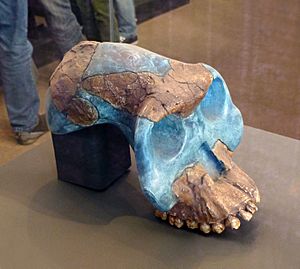Australopithecus garhi facts for kids
Quick facts for kids Australopithecus garhiTemporal range: Pliocene
|
|
|---|---|
 |
|
| Scientific classification | |
| Kingdom: | |
| Class: | |
| Order: | |
| Family: | |
| Subfamily: | |
| Genus: | |
| Binomial name | |
| †Australopithecus garhi Asfaw et al., 1997
|
|
Australopithecus garhi was an early human ancestor. It was a type of Australopithecus, a group of ancient human relatives. Scientists think A. garhi might be a direct ancestor of our own genus, Homo. Its fossils were found in Ethiopia in 1996.
Contents
Discovering Australopithecus garhi
Australopithecus garhi is a species of australopithecine. This means it was an early human relative. The word garhi means "surprise" in the local Afar language. Scientists found the first fossils of this species in 1996. They were discovered in a place called the Bouri Formation. This area is in the Middle Awash region of Ethiopia. It is part of the Afar Depression.
Why is A. garhi important?
Scientists believe A. garhi is a very important species. It might be a direct ancestor of humans. This means it could be a link between earlier ape-like ancestors and the first true humans. The fossils of A. garhi are about 2.5 to 2.6 million years old.
Earliest Stone Tools
One of the most exciting things about A. garhi is its connection to early stone tools. Some simple stone tools were found near the A. garhi fossils. These tools look like the Olduwan type of technology. They are also about 2.5 to 2.6 million years old.
For a long time, experts thought that only early humans from the Homo genus made complex tools. But finding tools with Australopithecus garhi changed this idea. It suggests that A. garhi might have been one of the first species to make and use stone tools. This discovery helps us understand how tool-making skills developed in our ancient relatives.
See also
 In Spanish: Australopithecus garhi para niños
In Spanish: Australopithecus garhi para niños

